(Photo by Joshua Sarner/Icon Sportswire)
Balance is generally a necessity when reaching stardom in professional baseball. Lagging in certain areas will show in the results, and when the results aren’t there, it’s difficult to attain that qualification as a “star.” Nolan Arenado is certainly a star, and he does not seem to be lacking in balance. Despite the obvious aid in the raw totals from his hometown Colorado Rockies stadium, Arenado does it all. He’s hit at least 37 home runs in the past three seasons, is on pace to do it again this season, while batting .287 or better each year. Arenado is actually in the midst of a career year, posting a .306/.388/.584 slash line. His 142 wRC+, which accounts for the stadium environment, would easily be his best. He’s done this all while being one of the best defensive third basemen in the league. What Arenado has done recently, though, is develop an imbalance.
Now, let me show you a chart. This chart contains the wOBA marks of right-handed hitters in 2018, with Arenado in red:
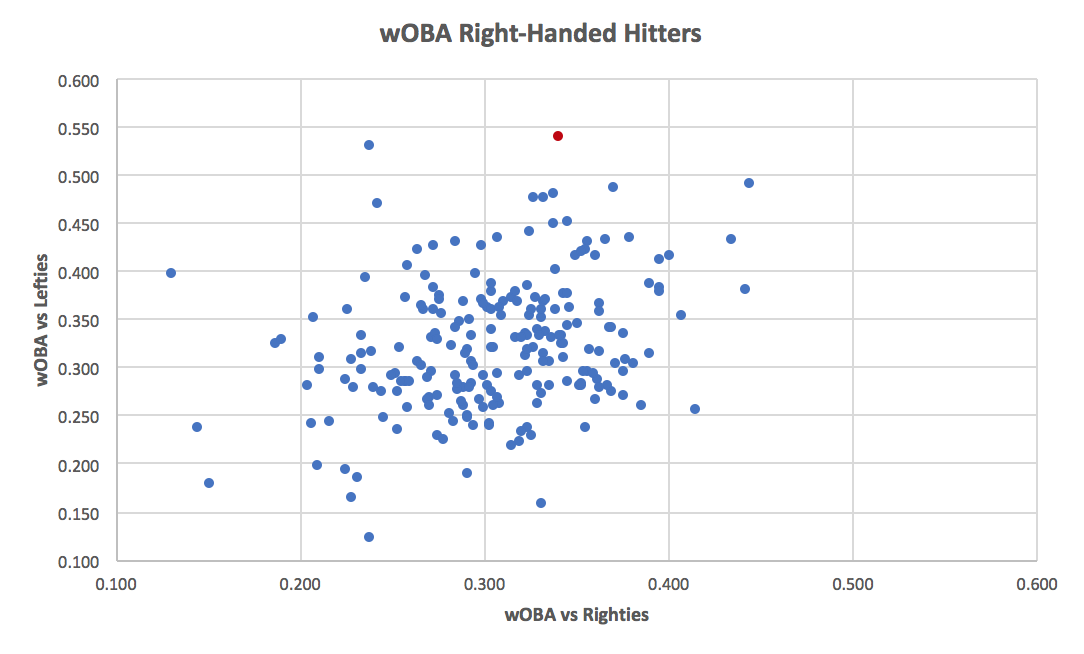
In 2018, Arenado has been the best right-handed hitter against lefties in baseball, by wOBA. wOBA against righties also likes him better than a lot of players. But wOBA doesn’t consider the park Arenado is playing in. Let’s look at wRC+. wRC+ also likes him as the best hitter in baseball against lefties this year! It does not shine the same light, however, on his results against righties. Arenado has a 231 wRC+ against southpaws this year, and a 94 wRC+ against righties. Here, his percentile ranks among RHH in multiple categories against the two types of pitchers:
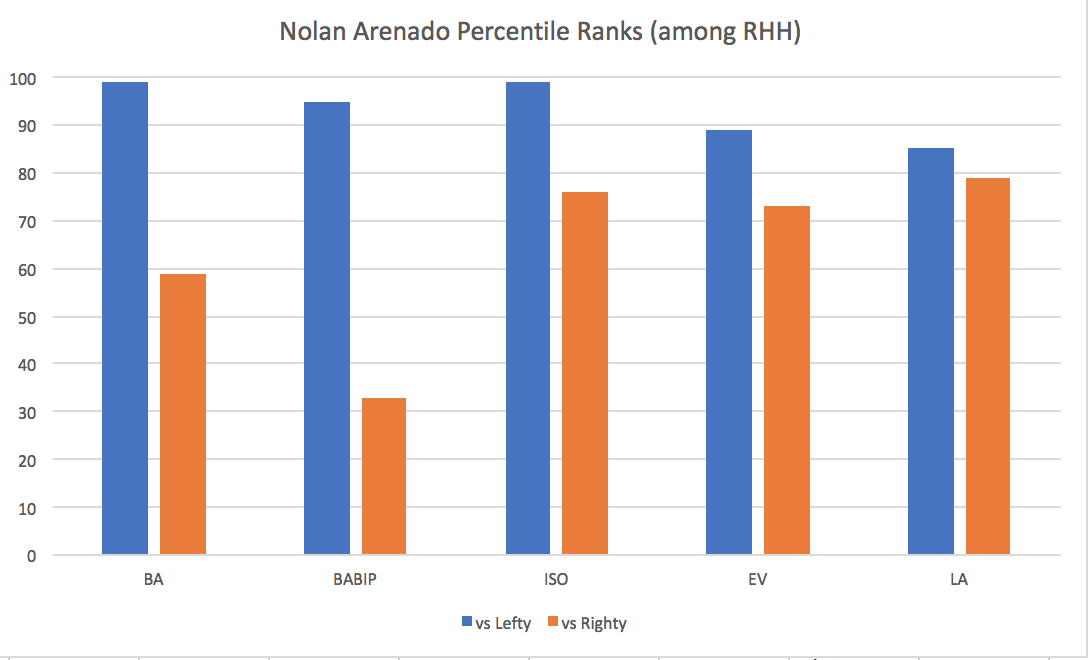
He performs better against lefties in every category – by a significant margin in some. While a 94 wRC+ against righties isn’t awful, it is below average. In conjunction with what he’s done against lefties, the overall results are awesome. But this at least represents a level of inconsistency for Arenado this season. A lack of balance.
There will always be blips in baseball, though. Is this an outlier for Arenado? Using one stat to create an entire evaluation is silly, but wRC+ can give us a pretty strong overall picture. Examine his left/right splits for each season by wRC+:
| Pitcher Handedness |
2015 | 2016 | 2017 | 2018 |
|---|---|---|---|---|
| Left | 81 | 109 | 220 | 231 |
| Right | 133 | 132 | 100 | 94 |
| Overall | 121 | 126 | 129 | 142 |
Between 2016 and 2017, Arenado took a 180. It has been more than 250 games now where he has absolutely destroyed lefties. That makes sense. Right-handed hitters are usually better in those situations. But it has also been more than 250 games where he has struggled against righties, which is kind of a problem. Final numbers aside, when nearly 2/3 of your plate appearances are coming against those righties, it’s a little disconcerting. How did Arenado end up here with such a sudden change?
With respect to plate discipline this season, he has been far better against lefties. He has walked 1.05 times for every strikeout against them. Arenado holds a 0.54 mark in the same category against the righties. We would expect this, though, as right-handed hitters typically see the ball better against lefties. Even when Arenado was far better against righty pitchers, his walk per strikeout numbers were significantly better facing lefties. Changing plate discipline is not the root.
What do Arenado’s batted ball frequencies look like year over year? xStats divides batted balls into six different categories, two of which are particularly indicative of skill level: dribbler rate (DB%) and high drive rate (HD%). As it sounds in the names, dribblers (along with pop ups) are the worst thing a hitter can do while high drives are the best thing a hitter can do. So, I point you to two charts. First, Arenado’s DB% (we want lower):

Arenado has displayed consistent growth in his DB% vs righties over the last two seasons and consistent decline of the same vs lefties. Now, the same for HD% (we want higher):
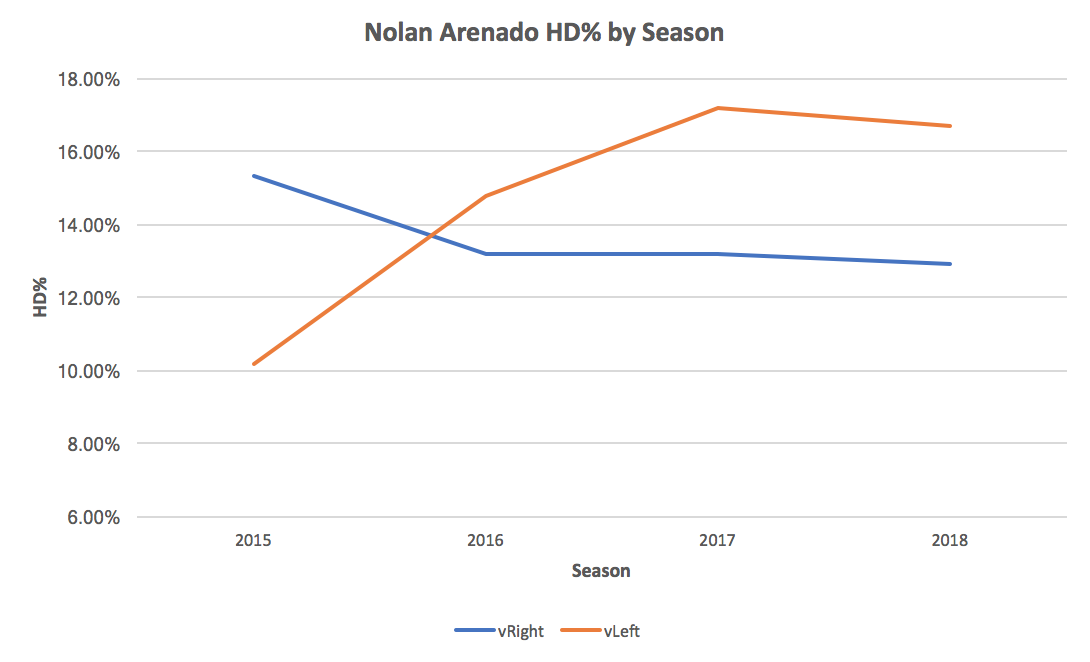
Arenado is displaying the same troubling thing against right-handed pitchers. Less high drives against them and more high drives against lefties. These two batted ball rates display a legitimate change in skill and show Arenado has vastly improved against southpaws. Why has a decline in production against righties gone hand-in-hand with growth against lefties?
In 2015-16, Arenado produced a .422 wOBA off of fastballs from righties. In 2017-18, that number has dropped to .359. Here is two fastball heat maps from those pitchers to Arenado, with 15-16 on the left and 17-18 on the right:
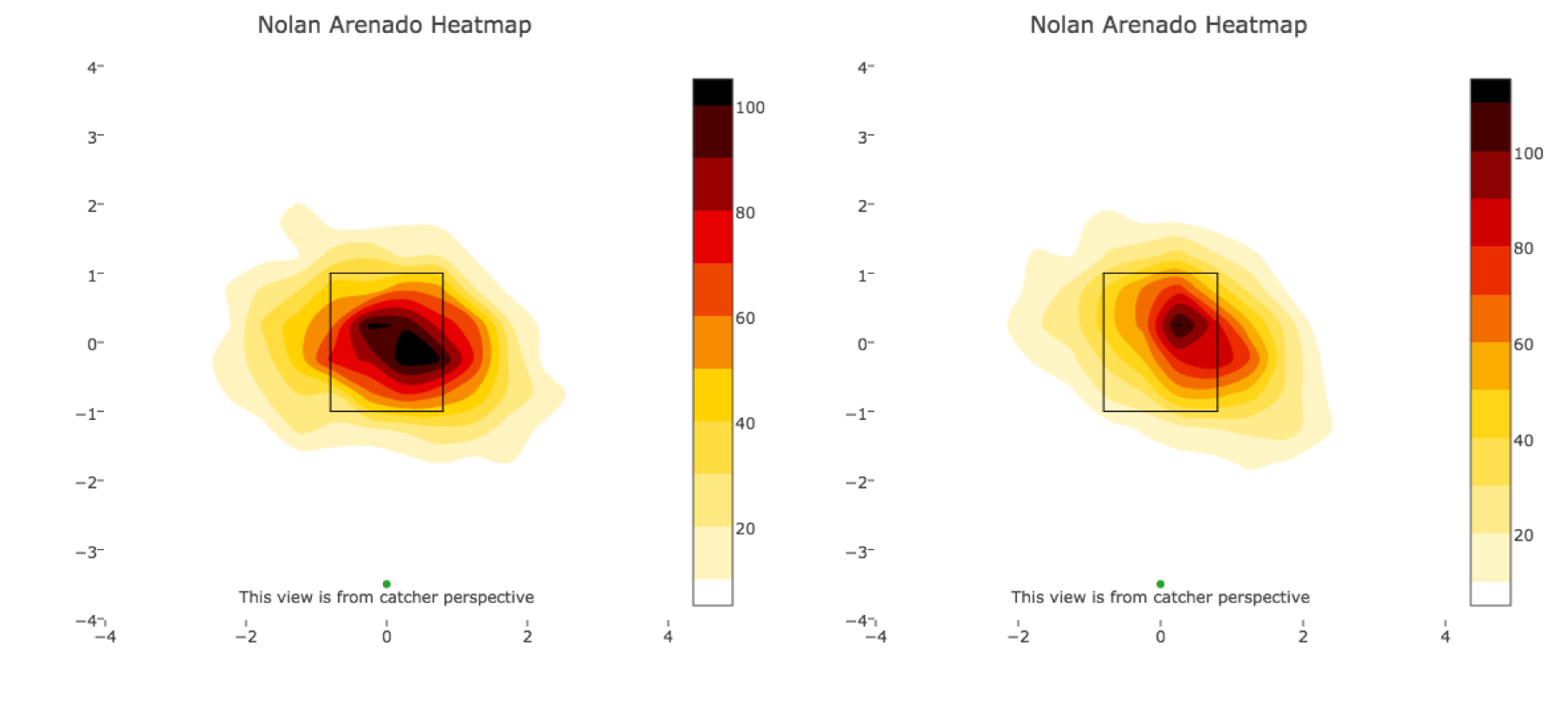
Arenado saw a lot of middle-located fastballs early in his career. Recently, pitchers have pounded up and away nearly exclusively. This seems to have completely sapped Arenado of his pull power against righties. Year over year since 2015, he has increasingly put more balls on the ground against those pitchers. In that same time frame, he has pulled fewer batted balls. Pulling more balls in the air is the best way to tap into home run hitting potential, and Arenado has done just the opposite against right-handed pitchers. In that 15-16 time frame, the bulk of his batted balls off righty fastballs hovered around a launch angle of 15 degrees. In 17-18, that same figure has been around 0 degrees. The result has been this:
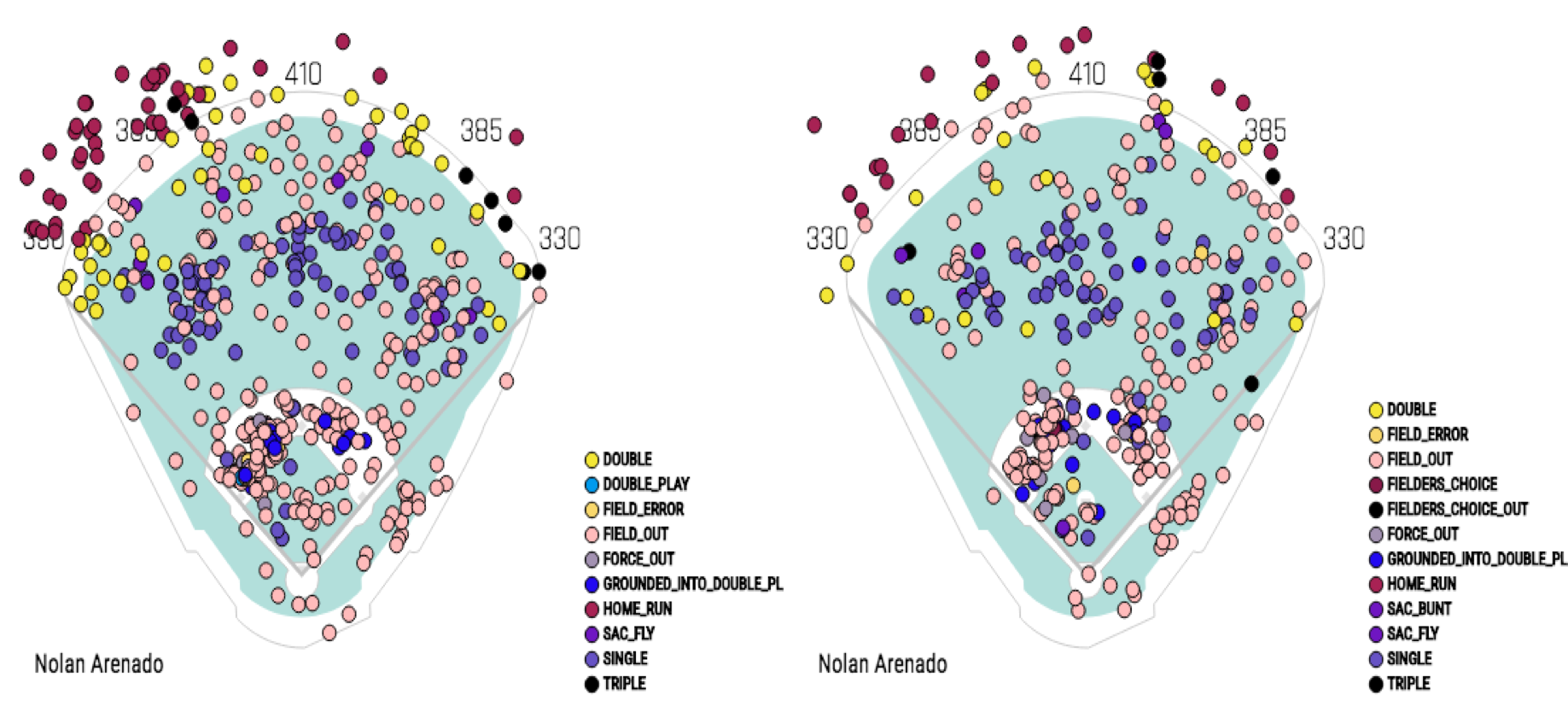
These are Arenado’s righty fastball spray charts in the two same selected time frames. 2018 isn’t over, of course. But look at the differences in the pull power. Between the home runs and doubles to the left field side, it does not look like the same hitter.
Yesterday, against the Houston Astros, Arenado batted four times. He faced a righty each time. He grounded out three times facing Charlie Morton and was popped up by Colin McHugh. Morton got him once doing exactly what it looks like we should come to expect from Arenado against righties:
[gfycat data_id=”MintyPlaintiveEmu”]
Morton elevated a fastball at the letters and Arenado beat it into the ground. That is happening far too often. His performance yesterday was largely indicative of what it has been like recently for Arenado against right-handed pitchers. Poorly hit balls and lots of outs.
This has probably seemed to carry too negative of a message for a guy who is having a career-best season and has already topped four WAR. The struggles against righties have not seemed to handicap him. Based off how impressive his batted ball numbers and plate discipline against lefties, I don’t see any reason to believe the overall production will decline. But that’s why I said Arenado has developed something. You probably don’t want to see your star have such mediocre results in the bulk of his trips to the plate. You want more balance. But the non-bulk of those trips have returned such incredible things that it is difficult to complain. I can’t say that the thing he has developed has been for the worse.
It’s impossible to say for certain what has caused Arenado’s recent tendencies, and it’s probably more than just an issue with fastballs from righties. But he has now displayed a consistent pattern. What I can say for certain that if Arenado ends up facing a string of right-handed pitchers outside of his home stadium, a lack of results should come as no surprise. It’s strange how Arenado ended up here, but this is the best version of him that we have ever seen.

I think the explanation is here: https://www.fangraphs.com/community/how-nolan-arenado-avoids-the-ground/